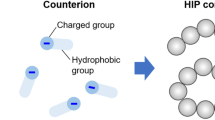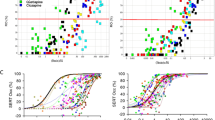Abstract
One of the major goals to improve drug discovery is to understand the molecular properties that influence oral bioavailability. Molecular dynamics-based methods have been used to understand passive diffusion with atomic detail and to predict diffusivities and permeabilities. In this paper, we explore the structural and dynamic behavior of piracetam, a nootropic drug, using umbrella sampling, as it crosses a 1,2-dioleoyl-sn-glycero-3-phosphocholine bilayer model. This is accompanied with a potential of mean force profile, showing the partition equilibrium within the bilayer. We discuss important molecular properties and their influence to the permeation of this important drug. Piracetam changes its solution-dominant conformation, modifying its polar surface area and forming an internal hydrogen bond, to facilitate penetration into the hydrophobic core. Rotation and orientation patterns, as piracetam diffuses across the membrane, were also analyzed, and we found out that in bulk water and at the membrane center piracetam shows no specific orientation as it rotates quickly and freely, whereas near the phospholipids’ polar head groups its polar atoms are much more oriented and the rotation is slowed down by more than one order of magnitude. Altogether, the study provides a very detailed view of the events mediating the permeation of this small and very polar drug.





Similar content being viewed by others
References
Li AP (2001) Screening for human ADME/Tox drug properties in drug discovery. Drug Discov Today 6:357–366
Chawla G, Gupta P, Koradia V, Bansal A (2003) A means to address regional variability in intestinal drug absorption. Pharm Technol 27:50–68
Lipinski CA (2000) Drug-like properties and the causes of poor solubility and poor permeability. J Pharmacol Toxicol Methods 44:235–249
Lipinski CA, Lombardo F, Dominy BW, Feeney PJ (2001) Experimental and computational approaches to estimate solubility and permeability in drug discovery and development settings. Adv Drug Deliv Rev 46:3–26
Veber DF, Johnson SR, Cheng HY (2002) Molecular properties that influence the oral bioavailability of drug candidates. J Med Chem 45:2615–2623
Lajiness MS, Vieth M, Erickson J (2004) Molecular properties that influence oral drug-like behavior. Curr Opin Drug Discov Dev 7:470–477
Meng F, Xu W (2013) Drug permeability prediction using PMF method. J Mol Model 19:991–997
Swift RV, Amaro RE (2013) Back to the future: can physical models of passive membrane permeability help reduce drug candidate attrition and move us beyond QSPR? Chem Biol Drug Des 81:61–71
Lee CT, Comer J, Herndon C et al (2016) Simulation-based approaches for determining membrane permeability of small compounds. J Chem Inf Model 56:721–733
Jämbeck J, Lyubartsev AP (2013) Exploring the free energy landscape of solutes embedded in lipid bilayers. J Phys Chem Lett 4:1781–1787
Gouliaev AH, Senning A (1994) Piracetam and other structurally related nootropics. Brain Res Brain Res Rev 19:180–222
Hitzenberger G, Rameis H, Manigley C (1998) Pharmacological properties of piracetam. CNS Drugs 9:19–27
Viswanadhan VN, Ghose AK, Revankar GR, Robins RK (1989) Atomic physicochemical parameters for three dimensional structure directed quantitative structure-activity relationships. 4. Additional parameters for hydrophobic and dispersive interactions and their application for an automated superposition of certain naturally occurring nucleoside antibiotics. J Chem Inf Model 29:163–172
Jo S, Kim T, Im W (2007) Automated builder and database of protein/membrane complexes for molecular dynamics simulations. PLoS ONE 2:e880
Jo S, Kim T, Iyer VG, Im W (2008) CHARMM-GUI: a web-based graphical user interface for CHARMM. J Comput Chem 29:1859–1865
Jo S, Lim JB, Klauda JB, Im W (2009) CHARMM-GUI Membrane Builder for mixed bilayers and its application to yeast membranes. Biophys J 97:50–58
Wu EL, Cheng X, Jo S et al (2014) CHARMM-GUI Membrane Builder toward realistic biological membrane simulations. J Comput Chem 35:1997–2004
Neale C, Bennett WFD, Tieleman DP, Pomès R (2011) Statistical convergence of equilibrium properties in simulations of molecular solutes embedded in lipid bilayers. J Chem Theory Comput 7:4175–4188
Tieleman DP (2006) Computer simulations of transport through membranes: passive diffusion, pores, channels and transporters. Clin Exp Pharmacol Physiol 33:893–903
MacCallum JL, Tieleman DP (2006) Computer simulation of the distribution of hexane in a lipid bilayer: spatially resolved free energy, entropy, and enthalpy profiles. J Am Chem Soc 128:125–130
Parisio G, Stocchero M, Ferrarini A (2013) Passive membrane permeability: beyond the standard solubility-diffusion model. J Chem Theory Comput 9:5236–5246
Carpenter TS, Kirshner DA, Lau EY, Wong SE (2014) A method to predict blood–brain barrier permeability of drug-like compounds using molecular dynamics simulations. Biophys J 107:630–641
Ulrich AS, Sami M, Watts A (1994) Hydration of DOPC bilayers by differential scanning calorimetry. BBA Biomembr 1191:225–230
Jämbeck JPM, Lyubartsev AP (2012) Derivation and systematic validation of a refined all-atom force field for phosphatidylcholine lipids. J Phys Chem B 116:3164–3179
Jämbeck J, Lyubartsev AP (2012) An extension and further validation of an all-atomistic force field for biological membranes. J Chem Theory Comput 8:2938–2948
Jämbeck J, Lyubartsev AP (2012) Another piece of the membrane puzzle: extending slipids further. J Chem Theory Comput 9:774–784
Jorgensen WL, Chandrasekhar J, Madura JD et al (1983) Comparison of simple potential functions for simulating liquid water. J Chem Phys 79:926–935
Wang J, Wang W, Kollman PA, Case DA (2005) Antechamber: an accessory software package for molecular mechanical calculations. J Comput Chem 25:1157–1174
Frisch MJ, Trucks GW, Schlegel HB et al (2004) Gaussian 03, Revision C.02. Gaussian Inc, Wallingford
Bayly CI, Cieplak P, Cornell WD, Kollman PA (1993) A well-behaved electrostatic potential based method using charge restraints for deriving atomic charges—the RESP model. J Phys Chem 97:10269–10280
Sousa da Silva AW, Vranken WF (2012) ACPYPE—antechamber python parser interface. BMC Res Notes 5:367
Paloncýová M, Fabre G, DeVane RH et al (2014) Benchmarking of force fields for molecule-membrane interactions. J Chem Theory Comput 10:4143–4151
van der Spoel D, Lindahl E, Hess B et al (2005) GROMACS: fast, flexible, and free. J Comput Chem 26:1701–1718
Verlet L (1967) Computer experiments on classical fluids. I. Thermodynamical properties of Lennard–Jones molecules. Phys Rev 159:98
Hess B, Bekker H, Berendsen H, Fraaije J (1997) LINCS: a linear constraint solver for molecular simulations. J Comput Chem 18:1463–1472
Nosé S (1984) A unified formulation of the constant temperature molecular dynamics methods. J Chem Phys 81:511–519
Hoover WG (1985) Canonical dynamics: equilibrium phase-space distributions. Phys Rev A Gen Phys 31:1695–1697
Parrinello M, Rahman A (1981) Polymorphic transitions in single-crystals—a new molecular-dynamics method. J Appl Phys 52:7182–7190
Rosso L, Gould IR (2008) Structure and dynamics of phospholipid bilayers using recently developed general all-atom force fields. J Comput Chem 29:24–37
Kucerka N, Nagle JF, Sachs JN et al (2008) Lipid bilayer structure determined by the simultaneous analysis of neutron and X-ray scattering data. Biophys J 95:2356–2367
Hub JS, De Groot BL (2010) g_wham—a free weighted histogram analysis implementation including robust error and autocorrelation estimates. J Chem Theory Comput 6:3713–3720
Hummer G (2005) Position-dependent diffusion coefficients and free energies from Bayesian analysis of equilibrium and replica molecular dynamics simulations. New J Phys 7:34
Humphrey W, Dalke A, Schulten K (1996) VMD: visual molecular dynamics. J Mol Graph 14:33–38
Paloncýová M, DeVane R, Murch B (2014) Amphiphilic drug-like molecules accumulate in a membrane below the head group region. J Phys Chem B 118:1030–1039
Miguel V, Defonsi Lestard ME, Tuttolomondo ME et al (2016) Molecular view of the interaction of S-methyl methanethiosulfonate with DPPC bilayer. Biochim Biophys Acta 1858:38–46
Bemporad D, Luttmann C, Essex JW (2004) Computer simulation of small molecule permeation across a lipid bilayer: dependence on bilayer properties and solute volume, size, and cross-sectional area. Biophys J 87:1–13
Boggara MB, Krishnamoorti R (2010) Partitioning of nonsteroidal antiinflammatory drugs in lipid membranes: a molecular dynamics simulation study. Biophys J 98:586–595
Marrink SJ, Berendsen H (1996) Permeation process of small molecules across lipid membranes studied by molecular dynamics simulations. J Phys Chem 100:16729–16738
Rezai T, Bock JE, Zhou MV et al (2006) Conformational flexibility, internal hydrogen bonding, and passive membrane permeability: successful in silico prediction of the relative permeabilities of cyclic peptides. J Am Chem Soc 128:14073–14080
Navia MA, Chaturvedi PR (1996) Design principles for orally bioavailable drugs. Drug Discov Today 1:179–189
Alex A, Millan DS, Perez M et al (2011) Intramolecular hydrogen bonding to improve membrane permeability and absorption in beyond rule of five chemical space. Med Chem Commun 2:669–674
Bemporad D, Luttmann C, Essex JW (2005) Behaviour of small solutes and large drugs in a lipid bilayer from computer simulations. Biochim Biophys Acta 1718:1–21
PasenkiewiczGierula M, Takaoka Y, Miyagawa H et al (1997) Hydrogen bonding of water to phosphatidylcholine in the membrane as studied by a molecular dynamics simulation: location, geometry, and lipid-lipid bridging via hydrogen-bonded water. J Phys Chem A 101:3677–3691
Leach AR (2001) Molecular modelling: principles and applications, 2nd edn. Pearson Education, Upper Saddle River
Acknowledgements
This work received financial support from the following institutions: European Union (FEDER funds POCI/01/0145/FEDER/007728) and National Funds (FCT/MEC, Fundação para a Ciência e Tecnologia and Ministério da Educação e Ciência) under the Partnership Agreement PT2020 UID/MULTI/04378/2013; NORTE-01-0145-FEDER-000024, supported by Norte Portugal Regional Operational Programme (NORTE 2020), under the PORTUGAL 2020 Partnership Agreement, through the European Regional Development Fund (ERDF); JTSC further thanks the FCT for Grant SFRH/BD/87434/2012.
Author information
Authors and Affiliations
Corresponding author
Additional information
Published as part of the special collection of articles derived from the 10th Congress on Electronic Structure: Principles and Applications (ESPA-2016).
Electronic supplementary material
Below is the link to the electronic supplementary material.
Rights and permissions
About this article
Cite this article
Ribeiro, R.P., Coimbra, J.T.S., Ramos, M.J. et al. Diffusion of the small, very polar, drug piracetam through a lipid bilayer: an MD simulation study. Theor Chem Acc 136, 46 (2017). https://doi.org/10.1007/s00214-017-2073-3
Received:
Accepted:
Published:
DOI: https://doi.org/10.1007/s00214-017-2073-3




